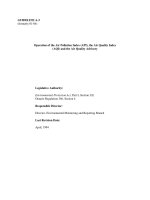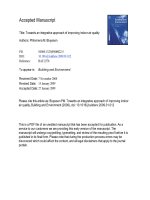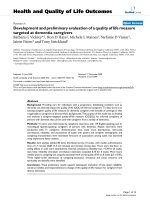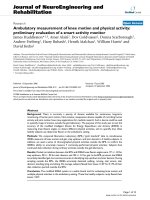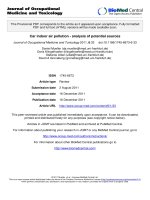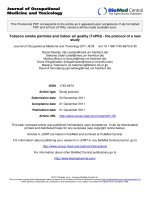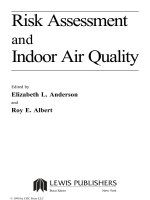Thermal comfort and indoor air quality evaluation of a ceiling mounted personalized ventilation system integrated with an ambient mixing ventilation system
Bạn đang xem bản rút gọn của tài liệu. Xem và tải ngay bản đầy đủ của tài liệu tại đây (2.37 MB, 300 trang )
THERMAL COMFORT AND INDOOR AIR QUALITY
EVALUATION OF A CEILING MOUNTED PERSONALIZED
VENTILATION SYSTEM INTEGRATED WITH AN AMBIENT
MIXING VENTILATION SYSTEM
YANG BIN
NATIONAL UNIVERSITY OF SINGAPORE
2009
THERMAL COMFORT AND INDOOR AIR QUALITY
EVALUATION OF A CEILING MOUNTED PERSONALIZED
VENTILATION SYSTEM INTEGRATED WITH AN AMBIENT
MIXING VENTILATION SYSTEM
YANG BIN
(B. Eng. Tianjin Univ., China;
M. Sc. Eng., Tianjin Univ., China)
A THESIS SUBMITTED
FOR THE DEGREE OF DOCTOR OF PHILOSOPHY
DEPARTMENT OF BUILDING, NATIONAL UNIVERSITY OF SINGAPORE
DEPARTMENT OF CIVIL ENGINEERING,TECHNICAL UNIVERSITY OF
DENMARK
2009
i
Acknowledgements
I would like to express my sincere gratitude to my supervisor A/P Sekhar, Sitaraman
Chandra of the National University of Singapore for his enlightening supervision,
valuable advices, constructive suggestions and fruitful discussions throughout my
Ph.D. journey from year 2004 to 2009. Being his student has been an enjoyable and
memorable experience. I am extremely appreciative to him for being always friendly
and available whenever he is approached for solving problems.
I would like to express my deepest acknowledgement to my supervisor A/P Melikov,
Arsen Krikor of the Technical University of Denmark. I am so fortunate working with
him, famous expert in personalized ventilation system. I learned his strictness to
research, his leniency to other person’s mistakes and his patience to young researchers.
I especially appreciate his valuable suggestions on my experimental design, data
analysis and thesis writing.
I am also grateful to my thesis committee members: A/P Tham Kwok Wai and A/P
Cheong Kok Wai, David, whose doors are always open, for freely sharing with me
their valuable knowledge, experience and expertise on any issues related to
personalized ventilation system.
I would like to thank Professor Olesen, Bjarne W. for inviting me to the International
ii
Center for Indoor Environment and Energy, Technical University of Denmark to be a
joint Ph.D. student under NUS-DTU joint Ph.D. program. I specially thank A/P Fang
Lei for his guidance of developing control system of personalized ventilation system.
I am also appreciative to Dr. Zhu Shengwei for optimizing my simulation model, A/P
Wargocki, Pawl and guest professor Zhang Yinping from Tsinghua University for
their instructive suggestion of experimental design, A/P Toftum, Jørn for his
suggestion of my subjective response tests.
I am appreciated to my thesis examiners, Professor Edward Arens from U. C.
Berkeley, A/P Toftum, Jørn from Danish Technical University and A/P Wong Nyuk
Hien from National University of Singapore.
Warmest thanks to my colleagues with whom I have had the privilege to work: Ms. Li
Ruixin for her selfless help in renovating Field Environmental Chamber, Dr. Henry
Cahyadi Willem for his suggestion about questionnaire survey.
Many people have assisted to my work generously:
In National University of Singapore: A/P Lee Siew Eang, A/P Wong Nyuk Hien, Dr.
Gong Nan, Dr Yu Weijiang, Sun Weimeng Daniel, Jovan Pantelic, Tan Seng Tee, Tan
Cheow Beng and Zuraimi Bin Mohd Sultan.
iii
In Technical University of Denmark: Professor Sundell Jan, A/P Clausen Geo, A/P
Langkilde Gunnar, Bolashikov Zhecho Dimitrov, Strøm-Tejsen Peter, Zukowska
Daria, Schiavon Stefano, Haneda Masaoki and Simonsen Peter Slotved.
The financial supports from National University of Singapore, ASHRAE graduate
Grant-in-aid (2007) and Chinese Government Award for Outstanding Self-financed
students Abroad (2008) are gratefully acknowledged.
Yang Bin, in Singapore
Final submission in Dec. 2009
iv
Table of Contents
Acknowledgements i
Table of Contents iv
Summary viii
List of Tables x
List of Figures xii
List of Symbols xxiv
List of Appendices xxvi
Chapter 1: Introduction 1
1.1 Background and Motivation 1
1.2 Research Objectives 5
1.3 Outline 6
Chapter 2: Literature Review 9
2.1 Tropical Climate and Conventional ACMV system 9
2.2 Personalized Ventilation 11
2.2.1 Air Terminal Device and Air Flow 11
2.2.2 PV Performance 16
2.3 Human Response to Thermal Environment and Air Movement 19
2.4 PV Related Studies in Hot and Humid Climates 21
2.5 Knowledge Gap 30
Chapter 3: Pilot Study
3.1 Introduction 32
3.2 Research Methodology 32
3.2.1 Physical Measurement 32
3.2.2 CFD Simulation 37
3.2.3 Parametric Variation Studies 39
3.3 Results and Discussion 40
3.3.1 Physical Measurements 41
3.3.2 CFD Simulation 41
v
3.3.2.1 CFD Simulation for Base Case 41
3.3.2.2 CFD Simulation for Parametric Variation Studies 43
3.3.3 Comparison of the Results Between Physical
Measurements and CFD Simulation 47
3.4 Preliminary Conclusions 48
3.5 Recommendations 48
Chapter 4: Performance Characteristics of Ceiling Mounted PV System
—Objective Measurements 49
4.1Objectives 49
4.2 Experimental Design 49
4.2.1 Facility 49
4.2.2 Instruments 55
4.2.2.1 Thermal Manikin 55
4.2.2.2 Temperature and Velocity Measurements 56
4.3 Experimental Conditions 59
4.4 Experimental Protocol and Evaluating Index 61
4.4.1 Airflow Profile 62
4.4.2 Cooling Effect 65
4.4.3 Inhaled Air Quality and Temperature 66
4.5 Experimental Results 67
4.5.1 Flow Interaction 67
4.5.2 Cooling Effect 74
4.5.3 Inhaled Air Quality 91
4.5.4 Inhaled Air Temperature 93
4.6 Discussion 96
4.7 Conclusions of Objective Measurements 99
Chapter 5: Human Response Studies of Ceiling Mounted PV System
—Subjective Assessments 102
5.1 Objectives 102
vi
5.2 Experimental Design 102
5.2.1 Experimental Facilities 103
5.2.2 Experimental Conditions 103
5.2.3 Subject Selection 103
5.2.4 Questionnaire Design 104
5.2.5 Experimental Procedure 107
5.3 Human Perception Analysis 111
5.3.1 Thermal Sensation 111
5.3.2 Air Movement Perception, Acceptability, Preference 119
5.3.3 Thermal Comfort Acceptability 125
5.3.4 Indoor Air Quality 126
5.3.5 Evaluation of Noise Level 129
5.3.6 Discussion 130
5.4 Human Perception Relation 132
5.4.1 Correlation Analysis within Human Perceptions 132
5.4.2 Correlation Analysis between Human Perceptions 141
5.4.3 Concluding Remarks 151
5.5 Dissatisfaction due to Air Movement 151
5.5.1 Percentage Dissatisfied 152
5.5.2 Final Choice of PV Airflow Rates under Individually
Controlled System 158
5.5.3 Individual Analysis under Different Exposed Conditions 167
5.5.4 Optimum Velocity and Acceptable Velocity Range 167
Chapter 6: Energy Saving Potential and Effect of Control Strategy of Ceiling
Mounted PV System 170
vii
6.1 Definition of Control Strategies 170
6.2 Energy Saving Potential 172
6.2.1 Description of Cooling Load in the Field Environmental Chamber
173
6.2.2 Design Parameters 173
6.2.3 Energy Consumption 174
6.2.3.1 Cooling Energy Consumption for Air Conditioning 174
6.2.3.2 Transport Energy Consumption 177
6.2.3.3 Total Energy Consumption 177
6.2.4 Energy Saving Potential Analysis 178
Chapter 7: Conclusion and Recommendation 181
7.1 Review and Achievement of Research Objectives 181
7.2 Recommendations 186
Bibliography 188
Appendix 1: Manikin Calibration Data 194
Appendix 2: Theory Analysis of Circular Free Jet (Isothermal Case) 198
Appendix 3: Detailed Description of Measuring Instruments 200
Appendix 4: Questionnaires 205
Appendix 5: Results of Objective Measurements 218
Appendix 6: Thermal comfort acceptability 224
Appendix 7: Perceived air quality acceptability 234
Appendix 8: Air movement preference 244
Appendix 9: List of Publications 254
viii
Summary
As the contribution towards the goal of excellent and sustainable indoor environment,
Ceiling mounted Personalized Ventilation (PV) has been developed based on
conventional PV system. Personalized air, which is fresh, dry and cool, is supplied
into breathing zone by ceiling mounted PV air terminal devices (ATD) without
extending ducts into breathing zone. As a result, indoor aesthetics and flexibility of
distributing indoor furniture are improved. However, the airflow characteristics and
subjective assessments to this system have not been explored.
The first objective of this study is to evaluate the performance of prototype of ceiling
mounted PV ATDs, with emphasis being placed on air movements characteristics
around human body,cooling effect, draft rating, inhaled air temperature and inhaled
air quality. This study is conducted at the Technical University of Denmark. The
second objective of this study is to investigate the responses from
tropically-acclimatized subjects to the local environment created with ceiling mounted
PV system, with emphasis being placed on thermal sensation, air movement
perception, acceptability and preference, perceived air temperature and perceived air
quality. This study is conducted in Singapore, a place with hot and humid climate.
For the first purpose, thermal breathing manikin is utilized as main experimental
facility, which can simulate breathing and heat generation of real person, give
quantitatively evaluation of cooling effect for different body segments under this
ceiling mounted PV system. The characteristics of flow field are measured by thermal
anemometer.
ix
For the second purpose, 32 tropically acclimatized subjects are chosen to give their
assessment to ceiling mounted PV system with emphasis on thermal sensation,
thermal comfort, air movement perception, acceptability and preference, perceived
inhaled air quality and temperature, feeling of indoor environment.
This study reveals the feasibility of the newly developed ceiling mounted PV system
for practical use in Tropic climate.
x
List of tables
Table 3.1
Table 3.2
Table 3.3
Table 4.1
Table 4.2
Table 5.1
Table 5.2
Table 5.3
Table 5.4
Table 5.5
Table 5.6
Table 5.7
Table 5.8
Table 5.9
Table 5.10
Table 5.11
Table 5.12
Table 5.13
Boundary conditions for supply diffusers and exhaust grills
Different simulation cases
Comparison between the measured and predicted results for
air velocity at occupant level
Jet parameters under different outlet flow rates with 95mm
outlet diameter
.Experimental conditions
Experimental conditions for subjective assessments
Anthropometric data for the subjects
Sequence of experiment and respective timings that each
group attended
Questionnaires to be answered during the course of
experiments corresponding to the time scale in Table 5.3
R
2
of logarithmic regression in Figure 5.4 to Figure 5.11
R
2
of regression in Figure 5.15 to Figure 5.20
R
2
of regression in Figure 5.21
R
2
of regression in Figure 5.22, Figure 5.23 and Figure 5.24
R
2
of linear regression in Figure 5.25
R
2
of regression in Figure 5.26, Figure 5.27 and Figure 5.28
Thermal comfort acceptability based on final choice of PV
airflow rates under different temperature combinations
Inhaled air quality acceptability based on final choice of
PV airflow rates under different temperature combinations
Optimum PV airflow rate and range
38
39
47
53
61
103
104
110
110
117
125
126
129
130
134
163
165
165
xi
Table 6.1
Table 6.2
Table 6.3
Table 6.4
Table 6.5
Various cases studied
Thermal Load
Cooling energy consumption for air conditioning under
control strategy 1
Transport energy consumption under control strategy 1
Total energy consumption under control strategy 1
173
173
174
174
176
xii
List of Figures
Figure 2.1
Figure 2.2
Figure 2.3
Figure 3.1
Figure 3.2
Figure 3.3
Figure 3.4
Figure 3.5
Figure 3.6
Figure 3.7
Figure 3.8
Figure 3.9
Figure 3.10
Figure 3.11
Figure 3.12
Figure 3.13
Prototype of some localized ventilation air terminal devices
(figure a from Johnson Controls (2005), figure b from Argon
Corporation (2005), figure c from Bauman and Arens
(1996), figure d from Matsunawa et al. (1995))
Prototype and some PV ATDs (figure a from Bolashikov et.
al (2003), figure b from Faulkner et. al (2004), figure c from
Melikov (2004), figure d from Bolashikov et. al (2003),
figure e from Zuo et. al (2002))
Airflow interaction around human body: (1)—free
convection flow, (2)—personalized airflow, (3)—respiration
flow, (4)—ventilation flow, (5)—thermal flow (Source:
Melikov (2004))
Schematic layout of the indoor environmental chamber
The ceiling supply diffuser and return grilles of mixing
ventilation System
The PVC pipe for distributing personalized air
Measuring points for velocity in breathing zone
Airflow anemometer and airflow hood
Thermo-anemometer and sound level meter
Models D for air diffuser
Angles of ambient air diffuser blade
Local outdoor air percentage (base case, plane B)
Air velocity (base case, plane B)
Local outdoor air percentage (case1, plane B)
Air velocity (case1, plane B)
Local outdoor air percentage (case2, plane B)
12
14
15
33
34
34
36
36
37
38
40
42
42
43
44
44
xiii
Figure 3.14
Figure 3.15
Figure 3.16
Figure 3.17
Figure 3.18
Figure 4.1
Figure 4.2
Figure 4.3
Figure 4.4
Figure 4.5
Figure 4.6
Figure 4.7
Figure 4.8
Figure 4.9
Figure 4.10
Figure 4.11a
Figure 4.11b
Figure 4.11c
Air velocity (case2, plane B)
Local outdoor air percentage (case3, plane B)
Air velocity (case3, plane B)
Local outdoor air percentage (case4, plane B)
Air velocity (case4, plane B)
Schematic layout of mixing ventilation system for PV lab
Schematic layout of personalized ventilation system for PV
chamber
Technical details of the jet diffuser for ceiling mounted PV
ATD
Breathing thermal manikin
Measurement points of SF
6
concentration
Schematic representation of distribution of SF
6
dosing and
sampling points
Distribution of Omni-directional thermal anemometer probes
Blockage effect for ceiling mounted PV airflow from
unheated manikin
Neutral level for evaluating influence of free convection
flow on PV airflow
Air velocity profile with 4 L/s personalized airflow rate
under 23.5°C/23.5°C isothermal case
Air velocity profile with 4 L/s personalized airflow rate
under 23.5°C/23.5°C isothermal case without manikin
Air velocity profile with 4 L/s personalized airflow rate
under 23.5°C/23.5°C isothermal case with unheated manikin
Air velocity profile with 4 L/s personalized airflow rate
under 23.5°C/23.5°C isothermal case with heated manikin
45
45
46
46
47
50
52
53
56
58
59
63
64
65
69
69
70
70
xiv
Figure 4.12a
Figure 4.12b
Figure 4.12c
Figure 4.12d
Figure 4.13
Figure 4.14a
Figure 4.14b
Figure 4.14c
Figure 4.14d
Figure 4.15a
Figure 4.15b
Figure 4.15c
Figure 4.15d
Figure 4.16a
Comparison of centreline velocity distribution without, with
unheated and with heated manikin at 4 L/s and
23.5°C/23.5°C isothermal case
Comparison of centreline velocity distribution without, with
unheated and with heated manikin at 8 L/s and
23.5°C/23.5°C isothermal case
Comparison of centreline velocity distribution without, with
unheated and with heated manikin at 12 L/s and
23.5°C/23.5°C isothermal case
Comparison of centreline velocity distribution without, with
unheated and with heated manikin at 16 L/s and
23.5°C/23.5°C isothermal case
Dimensionless neutral level as a function of personalized
airflow rates
Cooling effect analysis under different personalized airflow
rates.at 23.5°C/21°C
Cooling effect analysis under different personalized airflow
rates.at 23.5°C/23.5°C
Cooling effect analysis under different personalized airflow
rates.at 26°C/23.5°C
Cooling effect analysis under different personalized airflow
rates.at 26°C/26°C
Cooling effect analysis under different temperature
combinations.at 4 L/s personalized airflow rate
Cooling effect analysis under different temperature
combinations.at 8 L/s personalized airflow rate
Cooling effect analysis under different temperature
combinations.at 12 L/s personalized airflow rate
Cooling effect analysis under different temperature
combinations.at 16 L/s personalized airflow rate
Ranges of the segmented and whole-body equivalent
71
71
72
72
74
76
76
77
77
78
78
79
79
81
xv
Figure 4.16b
Figure 4.16c
Figure 4.16d
Figure 4.17
Figure 4.18
Figure 4.19
Figure 4.20
Figure 4.21a
Figure 4.21b
temperature tested at room air temperature of 23.5ºC and
personalised air temperature 21ºC. Each line end indicates
the highest and lowest of equivalent temperature
Ranges of the segmented and whole-body equivalent
temperature tested at room air temperature of 23.5ºC and
personalized air temperature 23.5ºC. Each line end indicates
the highest and lowest of equivalent temperature
Ranges of the segmented and whole-body equivalent
temperature tested at room air temperature of 26ºC and
personalized air temperature 23.5ºC. Each line end indicates
the highest and lowest of equivalent temperature
Ranges of the segmented and whole-body equivalent
temperature tested at room air temperature of 26ºC and
personalized air temperature 26ºC. Each line end indicates
the highest and lowest of equivalent temperature
Cooling effect analysis under different personalized airflow
rates for six body segments
Cooling effect analysis under different ambient/PV
temperature combinations for six body segments
Ranges of segmented equivalent temperature determined at
four PV/Ambient temperature combinations when PV
airflow rate was changed from 4 l/s to 16 l/s for six body
segments. Each line end indicates the highest and lowest of
equivalent temperature
Ranges of segmented equivalent temperature determined at
four PV airflow rates under four different PV/Ambient
temperature combinations for six body segments. Each line
end indicates the highest and lowest of equivalent
temperature
Occupant movement analysis under different moving
directions. at 16 L/s personalized airflow rate and
23.5°C/21°C temperature combinations
Occupant movement analysis under different moving
directions. at 16 L/s personalized airflow rate and
23.5°C/23.5°C temperature combinations
81
82
82
84
84
85
85
87
87
xvi
Figure 4.21c
Figure 4.21d
Figure 4.22a
Figure 4.22b
Figure 4.22c
Figure 4.22d
Figure 4.23
Figure 4.24
Figure 4.25
Figure 4.26
Figure 5.1
Figure 5.2
Figure 5.3
Occupant movement analysis under different moving
directions. at 16 L/s personalized airflow rate and
26°C/23.5°C temperature combinations
Occupant movement analysis under different moving
directions. at 16 L/s personalized airflow rate and 26°C/26°C
temperature combinations
Occupant movement analysis under different moving
directions. at 4 L/s personalized airflow rate and
23.5°C/23.5°C temperature combinations
Occupant movement analysis under different moving
directions. at 8 L/s personalized airflow rate and
23.5°C/23.5°C temperature combinations
Occupant movement analysis under different moving
directions. at 12 L/s personalized airflow rate and
23.5°C/23.5°C temperature combinations
Occupant movement analysis under different moving
directions. at 16 L/s personalized airflow rate and
23.5°C/23.5°C temperature combinations
Personal exposure effectiveness as a function of
personalized air flow rate (23.5°C/23.5°C and 23.5°C/21°C)
Personal exposure effectiveness as a function of
personalized air flow rate (26°C/26°C, 26°C/23.5°C and
26°C/21°C)
Inhaled air temperature as a function of personalized air flow
rate (23.5°C /23.5°C, 23.5°C /21°C and 23.5°C /No PV)
Inhaled air temperature as a function of personalized air flow
rate (26°C /26°C, 26°C /23.5°C, 26°C /21°C and 26°C /No
PV)
Linear visual analogue scales with intervals for assessment
of air movement acceptability
Three options for assessment of air movement preference
Subjects in the control room (left) and in the FEC
88
88
89
89
90
90
91
92
94
95
105
106
109
xvii
Figure 5.4
Figure 5.5
Figure 5.6
Figure 5.7
Figure 5.8
Figure 5.9
Figure 5.10
Figure 5.11
Figure 5.12
Logarithmic regression of head thermal sensation as a
function of the personalized flow rate. Y-axis: -3=Cold;
-2=Cool; -1=Slightly cool; 0=Neutral; 1=Slightly warm;
2=Warm; 3=Hot
Logarithmic regression of facial thermal sensation as a
function of the personalized flow rate. Y-axis: -3=Cold;
-2=Cool; -1=Slightly cool; 0=Neutral; 1=Slightly warm;
2=Warm; 3=Hot
Logarithmic regression of neck thermal sensation as a
function of the personalized flow rate. Y-axis: -3=Cold;
-2=Cool; -1=Slightly cool; 0=Neutral; 1=Slightly warm;
2=Warm; 3=Hot
Logarithmic regression of back thermal sensation as a
function of the personalized flow rate. Y-axis: -3=Cold;
-2=Cool; -1=Slightly cool; 0=Neutral; 1=Slightly warm;
2=Warm; 3=Hot
Logarithmic regression of chest, shoulder and upper arm
thermal sensation as a function of the personalized flow rate.
Y-axis: -3=Cold; -2=Cool; -1=Slightly cool; 0=Neutral;
1=Slightly warm; 2=Warm; 3=Hot
Logarithmic regression of lower arm and hands thermal
sensation as a function of the personalized flow rate. Y-axis:
-3=Cold; -2=Cool; -1=Slightly cool; 0=Neutral; 1=Slightly
warm; 2=Warm; 3=Hot
Logarithmic regression of lower body thermal sensation as a
function of the personalized flow rate. Y-axis: -3=Cold;
-2=Cool; -1=Slightly cool; 0=Neutral; 1=Slightly warm;
2=Warm; 3=Hot
Logarithmic regression of whole body thermal sensation as a
function of the personalized flow rate. Y-axis: -3=Cold;
-2=Cool; -1=Slightly cool; 0=Neutral; 1=Slightly warm;
2=Warm; 3=Hot
Facial thermal sensation at different temperature
combinations and flow rate of 4, 8, 12 and 16 L/s. Y-axis:
-3=Cold; -2=Cool; -1=Slightly cool; 0=Neutral; 1=Slightly
113
113
114
114
115
115
116
116
118
xviii
Figure 5.13
Figure 5.14
Figure 5.15
Figure 5.16
Figure 5.17
Figure 5.18
Figure 5.19
Figure 5.20
Figure 5.21
Figure 5.22
warm; 2=Warm; 3=Hot
Lower body thermal sensation at different temperature
combinations and flow rate of 4, 8, 12 and 16 L/s. Y-axis:
-3=Cold; -2=Cool; -1=Slightly cool; 0=Neutral; 1=Slightly
warm; 2=Warm; 3=Hot
Whole body thermal sensation at different temperature
combinations and flow rate of 4, 8, 12 and 16 L/s. Y-axis:
-3=Cold; -2=Cool; -1=Slightly cool; 0=Neutral; 1=Slightly
warm; 2=Warm; 3=Hot
Logarithmic regression of whole body air movement
perception as a function of the flow rate. Y-axis: -3=much
too still; -2=too still; -1=slightly still; 0=just right; 1=slightly
breezy; 2=too breezy; 3=much too breezy
Logarithmic regression of face air movement perception as a
function of the flow rate. Y-axis: -3=much too still; -2=too
still; -1=slightly still; 0=just right; 1=slightly breezy; 2=too
breezy; 3=much too breezy
Quadratic regression of whole body air movement
acceptability as a function of the flow rate. Y-axis: -1=very
unacceptable; 0=just unacceptable/acceptable; +1=very
acceptable
Quadratic regression of face air movement acceptability as a
function of the flow rate. Y-axis: -1=very unacceptable;
0=just unacceptable/acceptable; +1=very acceptable
Logarithmic regression of whole body air movement
preference as a function of the flow rate. Y-axis: -1=less air
movement; 0=no change; +1=more air movement
Logarithmic regression of face air movement preference as a
function of the flow rate. Y-axis: -1=less air movement;
0=no change; +1=more air movement
Quadratic regression of thermal comfort acceptability as a
function of the flow rate. Y-axis: -1=very unacceptable;
0=just unacceptable/acceptable; +1=very acceptable
Linear regression of perceived air quality as a function of the
118
119
121
121
122
123
124
124
125
127
xix
Figure 5.23
Figure 5.24
Figure 5.25
Figure 5.26
Figure 5.27
Figure 5.28
Figure 5.29
Figure 5.30
Figure 5.31
flow rate. Y-axis: -1=very unacceptable; 0=just
unacceptable/acceptable; +1=very acceptable
Logarithmic regression of perceived inhaled air temperature
as a function of the flow rate. Y-axis: -3=Cold; +3=Hot
Linear regression of inhaled air freshness as a function of the
flow rate. Y-axis: 0= Air stuffy; 100=Air fresh
Linear regression of satisfaction of noise level as a function
of the flow rate. Y-axis: -1= Dissatisfied; +1=Satisfied
Linear regression of whole body thermal sensation and facial
thermal sensation. Y-axis and X axis: -3=Cold; -2=Cool;
-1=Slightly cool; 0=Neutral; 1=Slightly warm; 2=Warm;
3=Hot
Linear regression of whole body thermal sensation and neck
thermal sensation. Y-axis and X axis: -3=Cold; -2=Cool;
-1=Slightly cool; 0=Neutral; 1=Slightly warm; 2=Warm;
3=Hot
Linear regression of whole body thermal sensation and head
thermal sensation. Y-axis and X axis: -3=Cold; -2=Cool;
-1=Slightly cool; 0=Neutral; 1=Slightly warm; 2=Warm;
3=Hot
Quadratic regression of facial air movement acceptability
and facial air movement perception. Y-axis: -1=very
unacceptable; 0=just unacceptable/acceptable; +1=very
acceptable. X-axis: -3=much too still; -2=too still;
-1=slightly still; 0=just right; 1=slightly breezy; 2=too
breezy; 3=much too breezy
Quadratic regression of whole body air movement
acceptability and whole body air movement perception.
Y-axis: -1=very unacceptable; 0=just
unacceptable/acceptable; +1=very acceptable. X-axis:
-3=much too still; -2=too still; -1=slightly still; 0=just right;
1=slightly breezy; 2=too breezy; 3=much too breezy
Quadratic regression of facial air movement acceptability
and facial air movement preference. Y-axis: -1=very
unacceptable; 0=just unacceptable/acceptable; +1=very
128
129
130
133
133
134
136
137
138
xx
Figure 5.32
Figure 5.33
Figure 5.34
Figure 5.35
Figure 5.36
Figure 5.37
Figure 5.38
acceptable. X-axis: -1=less air movement; 0=no change;
+1=more air movement
Quadratic regression of whole body air movement
acceptability and whole body air movement preference.
Y-axis: -1=very unacceptable; 0=just
unacceptable/acceptable; +1=very acceptable. X-axis:
-1=less air movement; 0=no change; +1=more air movement
Linear regression of facial air movement preference and
facial air movement perception. Y-axis: -1=less air
movement; 0=no change; +1=more air movement. X-axis:
-3=much too still; -2=too still; -1=slightly still; 0=just right;
1=slightly breezy; 2=too breezy; 3=much too breezy
Linear regression of whole body air movement preference
and whole body air movement perception. Y-axis: -1=less air
movement; 0=no change; +1=more air movement. X-axis:
-3=much too still; -2=too still; -1=slightly still; 0=just right;
1=slightly breezy; 2=too breezy; 3=much too breezy
Quadratic regression of thermal comfort acceptability and
facial thermal sensation. Y-axis: -1=very unacceptable;
0=just unacceptable/acceptable; +1=very acceptable. X-axis:
-3=Cold; -2=Cool; -1=Slightly cool; 0=Neutral; 1=Slightly
warm; 2=Warm; 3=Hot
Quadratic regression of thermal comfort acceptability and
whole body thermal sensation. Y-axis: -1=very unacceptable;
0=just unacceptable/acceptable; +1=very acceptable. X-axis:
-3=Cold; -2=Cool; -1=Slightly cool; 0=Neutral; 1=Slightly
warm; 2=Warm; 3=Hot
Linear regression of facial air movement perception and
facial thermal sensation. Y-axis: -3=much too still; -2=too
still; -1=slightly still; 0=just right; 1=slightly breezy; 2=too
breezy; 3=much too breezy. X-axis: -3=Cold, -2=Cool,
-1=Slightly cool, 0=Neutral, 1=Slightly warm, 2=Warm,
3=Hot
Linear regression of whole body air movement perception
and whole body thermal sensation. Y-axis: -3=much too still;
-2=too still; -1=slightly still; 0=just right; 1=slightly breezy;
2=too breezy; 3=much too breezy. X-axis: -3=Cold;
138
140
140
142
142
144
144
xxi
Figure 5.39
Figure 5.40
Figure 5.41
Figure 5.42
Figure 5.43
Figure 5.44
Figure 5.45
-2=Cool; -1=Slightly cool; 0=Neutral; 1=Slightly warm;
2=Warm; 3=Hot
Quadratic regression of facial air movement acceptability
and facial thermal sensation. Y-axis: -1=very unacceptable;
0=just unacceptable/acceptable; +1=very acceptable. X-axis:
-3=Cold; -2=Cool; -1=Slightly cool; 0=Neutral; 1=Slightly
warm; 2=Warm; 3=Hot
Quadratic regression of whole body air movement
acceptability and whole body thermal sensation. Y-axis:
-1=very unacceptable; 0=just unacceptable/acceptable;
+1=very acceptable. X-axis: -3=Cold; -2=Cool; -1=Slightly
cool; 0=Neutral; 1=Slightly warm; 2=Warm; 3=Hot
Linear regression of facial air movement preference and
facial thermal sensation. Y-axis: -1=less air movement; 0=no
change; +1=more air movement. X-axis: -3=Cold; -2=Cool;
-1=Slightly cool; 0=Neutral; 1=Slightly warm; 2=Warm;
3=Hot
Linear regression of whole body air movement preference
and whole body thermal sensation. Y-axis: -1=less air
movement; 0=no change; +1=more air movement. X-axis:
-3=Cold; -2=Cool; -1=Slightly cool; 0=Neutral; 1=Slightly
warm; 2=Warm; 3=Hot
Quadratic regression of thermal comfort acceptability and
whole body air movement perception. Y-axis: -1=very
unacceptable; 0=just unacceptable/acceptable; +1=very
acceptable. X-axis: -3=much too still; -2=too still;
-1=slightly still; 0=just right; 1=slightly breezy; 2=too
breezy; 3=much too breezy
Linear regression of thermal comfort acceptability and
whole body air movement acceptability. Y-axis and X-axis:
-1=very unacceptable; 0=just unacceptable/acceptable;
+1=very acceptable
Quadratic regression of thermal comfort acceptability and
whole body air movement preference. Y-axis: -1=very
unacceptable; 0=just unacceptable/acceptable; +1=very
acceptable. X-axis: -1=less air movement; 0=no change;
+1=more air movement
145
146
147
148
149
150
150
xxii
Figure 5.46
Figure 5.47
Figure 5.48
Figure 5.49
Figure 5.50
Figure 5.51
Figure 5.52
Figure 5.53
Figure 5.54
Figure 5.55
Figure 5.56
Figure 5.57
Figure 5.58
Figure 6.1
Percentage of subjects’ air movement preference at
23.5°C/21°C
Percentage of subjects’ air movement preference at
23.5°C/23.5°C
Percentage of subjects’ air movement preference at
26°C/21°C
Percentage of subjects’ air movement preference at
26°C/23.5°C
Percentage of subjects’ air movement preference at
26°C/26°C
Percentage dissatisfied—prefer less air movement
Percentage dissatisfied—prefer more air movement
Comparison of the percentage of subjects preferring less air
movement and the percentage of subjects dissatisfied and
preferring less air movement
Comparison of the percentage of subjects preferring more air
movement and the percentage of subjects dissatisfied and
preferring more air movement
Percentage of subjects with their final choice of PV airflow
rates
Maximum, minimum and mean values of thermal comfort
acceptability based on subjects’ final choice. Y-axis: -1=very
unacceptable; 0=just unacceptable/acceptable; +1=very
acceptable
Maximum, minimum and mean values of inhaled air quality
acceptability based on subjects’ final choice. Y-axis: -1=very
unacceptable; 0=just unacceptable/acceptable; +1=very
acceptable
Quadratic regression of Percentage dissatisfied and PV
airflow rate
Air conditioning and air distribution system in field
153
153
154
154
155
156
157
157
158
160
160
161
168
175
xxiii
Figure 6.2
Figure 6.3
Figure 6.4
environmental chamber
Total energy consumption for different cases (9L/s PV
airflow rate, 10 ATDs)
Total energy consumption for different cases (4.5L/s PV
airflow rate, 10 ATDs)
Total energy consumption for different cases (9L/s PV
airflow rate, 16 ATDs)
176
178
178
